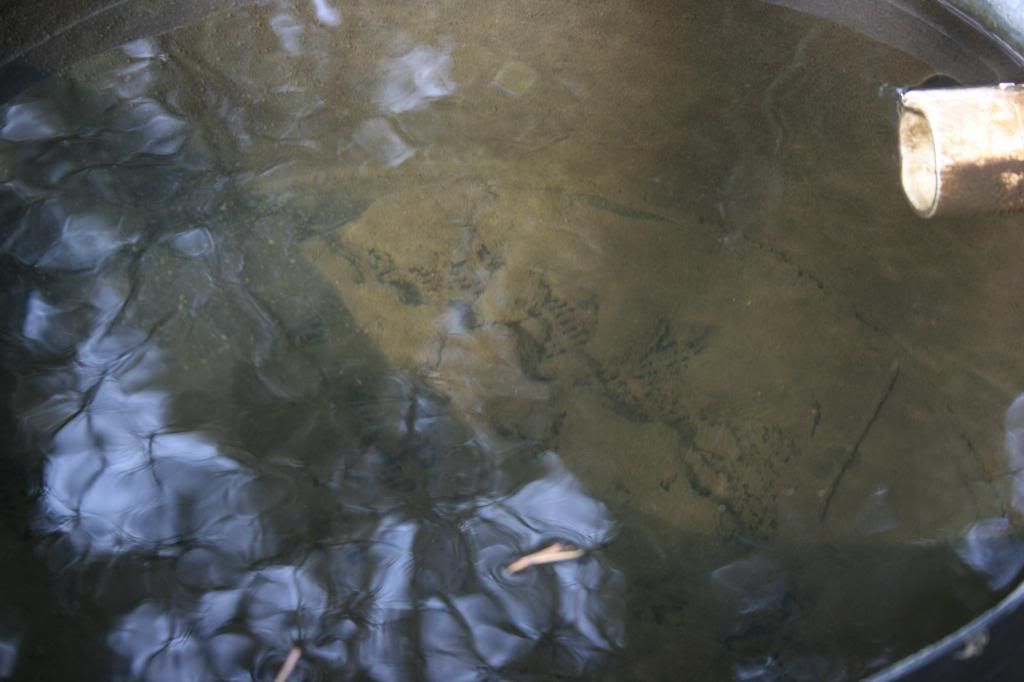This afternoon I went down to the incubator intent on cleaning out the trays and preparing for the next stage of the fishes' growth. The most encouraging sign was the sheer amount of water coming out of the incubator's exit pipe.

I pulled the top off the incubator and this is what I saw:

The clumps of greenish-brown matter are gluey deposits made up of dead eggs, egg shells, silt and clay particles. When you stir up the water the silt and egg shells, which are pretty light, get released and drift out the exit pipe. I stirred up the top tray a couple times, let the water clear, and then brought the tray close to the surface. Sitting on the tray were three or four late hatching alevin. Here's what one of them looked like:

I was pretty surprised that there were any alevin at all. Usually, they would all be hatched out and have matured to their next stage, fry, by now. The few alevin that were in there had hatched only recently. My aim would be to keep them in the incubator if I could by tilting the tray and letting them slide over the lip and down into the barrel. While I was looking for more alevin, I noticed my first coho salmon fry of the season:

There are probably 65,000 - 69,000 salmon fry in the barrel right now. That little guy is one of the adventurous ones. It's hard to tell exactly how many are there, but I'll show you how I estimated that.
Once I rescued as many of the alevin and fry as I could from the tray, I took the tray into McAleer creek and washed off as much of the gunk on those clumps of eggs as I could. This is what the tray with its dead eggs looks like after that.

It looks to me like there are 200-300 dead eggs there. The other two trays looked about the same. So, if I take the high estimate of 300 and multiply by 3, I get about 900 - 1,000. So, my high estimate for hatch rate would be 69,000/70,000, about a 98% hatch rate which is pretty darn good, if I do say so myself.
My plan was to clean the top two trays, then pull the bottom tray and replace it with one of the clean ones. If you don't do that, the bag of plastic media floats to the surface and makes it hard for the fry to find anyplace to swim. I pulled the third tray and replaced it with a clean one. Once that was done, I cleaned out the clarifier a bit. When I looked back into the incubator, I was not terribly surprised to see that quite a few fry had begun to migrate into the upper part of the incubator. These explorers are almost done growing. Here's a closeup look at one of them:

He's just resting on the big U-shaped piece of piping that I use for an exit screen. There are literally hundreds of tiny holes drilled into that pipe. I know this because I drilled all of them. The fry is almost done growing and will be ready for release within a month. Look closely and you can see that its belly is still absorbing part of its yolk sac; its got a reddish bulge right there in its middle. I love their little red tails and fins. The fry are really delicate looking and in reality they are pretty delicate. If I let them go right now, many of them would not survive the next week. If I keep them for another month, they'll be much tougher and ready to live in the wild. Most of them will become food for something else, but that's why I raise so many. If I get a 1% return, then 700 fish will be migrating up McAleer Creek. I haven't seen that many fish returning yet, so my return rate must be significantly less than 1%. Seems depressing, but it isn't, really. Even if very few of the fish return, they are still enriching the food chain all along the way. Dolly Varden trout in Lake Washington, kingfishers, great blue heron, frogs, other salmon, otters, seals, and orcas will all have meals compliments of yours truly. I say, "Have a great dinner." Putting fish back into the water is what it's all about. Building up the biosystem is my aim; that and getting a chance to play in the water!

This one is waiting on the exit pipe, close to his eventual route to Lake Washington and the sea. Hang on little fella', you're not quite ready to go yet. Your time will come soon enough.
1 comment:
Awesome pictures Dad! It's great to see the salmon are doing so well, but I'm curious about other animals you're raising right now...those of a furrier disposition. Again, amazing pictures!
Post a Comment